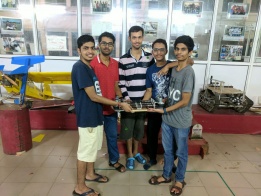What it does
The robot treads along the inside of a rail track and using ultrasound technology,it detects cracks big enough to cause derailments and saves the data.When it reaches the earmarked station,we would retrieve the data and initiate repair work at the earliest.
Your inspiration
Railways hold a vital position in the inland travel and transport scenario of the country.Covering around 115,000 km across the country it is precious to the economy.One major hindrance that we believe plagues the colossal system is that of maintenance of rail tracks.Owing to the sheer magnitude of the length of tracks,it becomes arduous to manually go and check for cracks in tracks; which if left undetected,may lead to derailments(Causes great loss of life).All this can be changed if we put in place a system that automatically checks for cracks along all the tracks,analyses them and alerts us to initiate repair work in time.
How it works
This robot would travel along a track and using ultrasound technology, it would detect cracks.It would then go on to analyse cracks big enough to cause derailments and save the data.When the robot reaches the earmarked station, we would retrieve the data and would come to know exactly where the cracks are located and the repair work can be initiated at the earliest.This will save a lot of time as the robot will be quicker than the normal human pace(it would move at about 4cm/s without stopping).It moves on the insides of the railway tracks and a train can simultaneously run on the tracks;thereby eliminating the delay in railway schedules for maintenance purposes.The tracks have ‘FISH-PLATES’ and nuts;this has been taken care of by the unique suspension system that supports the motion of the robot over these hurdles.The suspension system consists of a spring system along with each wheel(which has an axis perpendicular to the ground)and can accommodate hurdles.
Design process
(Refer to initial hurdles image) The first proposal was for the bot to move between the tracks. However, gravel present on the track made it bumpy, causing the bot to topple. Prototype-1:(img1)Attached to only one side of the rail track and fit between the fillet and the base, the bot moves forward. It is prevented from falling by using magnets. Problems- Railway track pieces are frequently attached using fishplates(img-2). They protrude beyond the head of the track, thus the bot cannot cross them. Prototype-2: (img-3,4) A second bot with the same design on the other track and a contractible rod attached to the two bots was added. When a fishplate is encountered on one side, the rod attached to that bot contracts. The other bot is still in contact with the track and the body as a whole moves forward. After traversing the length of the fishplate, the rod extends back to its original state. Problems-A lot of energy would be wasted on contracting and elongating the rod. Due to the high frequency of fishplates this would have made the movement of the bot sluggish. Final Prototype: Fishplates were the major issue. They are similar to speed bumps; Vehicles traverse over speed bumps through suspension systems. Hence, using this analogy we incorporated the suspension system into our bot.
How it is different
The methods used by the railways for accident deterrence cause disruptions in the regular working of the Indian Railways, causing losses.Our idea can be integrated into the existing rail system seamlessly.This is evident in the fact that we can claim to be having one of a kind design of the bot body,which does not need sensors to be present on both sides of the track and utilizes the free space in the rail tracks for operation.Our unique suspension design and placing ensures that the bot has enough grip on the tracks to hold itself up, without ever touching the ground.This novel idea causes the bot to smoothly pass over the fishplates and nut-bolts.Also the choice of materials for the bot is done in a way to optimize the cost,weight and other factors.The bot design facilitates the addition and usage of equipment for the main purpose (crack detection) as well as for secondary purposes like surveillance.This design is modular and indeed a novel idea.
Future plans
In the future we hope to collaborate with the government and to put our system in place on a large scale, so that accidents can be prevented. Regarding the design, as mentioned earlier, we plan to add image processing tech to the bot, so that it can assess the danger due to the crack, or any other damage to the tracks. The bot can also be used for the surveillance of the rail tracks by adding cctv cameras that stream the video feed to a control room. This helps in fighting illegal activities and terrorism. We can also use better sensors in the future.
Awards
Presently working on the prototype( images above).



Share this page on
LinkedIn
Facebook
Twitter